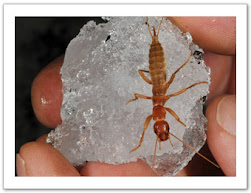Ice Crawlers are only found in western North America and Canada and in northeast Asia. In these areas this plucky insect has carved out a place for itself where they have less risk of being preyed upon and are not competing with other insects. They thrive in temperatures that hover around the freezing mark, but they will freeze to death if it gets much lower. Conversely, temperatures much above that point will kill them as well. In fact, merely holding them in a warm hand too long can kill them. They have adapted to living on mountains as temperatures there tend to be more stable than in lower altitudes. And if it gets too cold, they will go underground or under the snow (an insect igloo). Their preferred temperature range is too cold for most insects; the ones that venture there quickly die. There are also fewer of the common predators (birds, small mammals) up there, but if one comes too close they will retreat into their underground lairs. In addition to all these adaptions, Ice Crawlers have adopted a nocturnal lifestyle to further enhance their survival chances.
If high altitude landscapes offer specific survival benefits for Ice Crawlers, they also offer little in the way of food. Ice Crawler has adapted to this in a very basic way – they’ll pretty much eat anything they come across. It is believed that they feed on aerial plankton, but they also scavenge under rocks for decaying plant
matter or mosses. Additionally, they will snap up any hapless flies or moths that made the fatal error of visiting the snowy realms.
Submitted by Pam
matter or mosses. Additionally, they will snap up any hapless flies or moths that made the fatal error of visiting the snowy realms.
Ice Crawlers have an unusually long lifespan for an insect. Long lives are common amongst cold weather dwellers, and for the Ice Crawler it can take as much as 7 years to complete a life cycle from egg to adult. Add to that the year or so that an adult can live, and you got yourself the Methuselah of the insect world.
Submitted by Pam










No comments:
Post a Comment